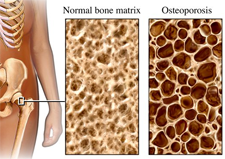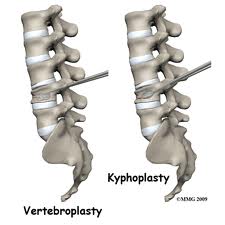A new study from the University of Toronto/Ontario has shown that contrary to the conventional teaching ostoporosis is not only a problem in females, but also a problem in males. The Canadian Multicentre Osteoporosis Study (CaMos) showed according to the epidemiologist Natalia Diaz-Granados that in Canada 16% of all women above the age of 50 and 5% of men above the age of 50 developed osteoporosis.
In the past men were thought to be more or less immune to osteoporosis, but this is not so. The results of this study were presented recently at the annual meeting of the American Society for Bone and Mineral Research in Minneapolis. 1,768 of the 2,884 men who were recruited into CaMos were eligible for the study, because they had not taken oral corticosteroids for three months, and bone scans were taken to measure bone density of their upper femurs (upper thigh bones). 89 men (or 5% of the group of 1768) showed osteoporosis. The mean age of this group was 65 years ranging from 50 to 96.
The researchers studied the high risk factors in men with osteoporosis and found that they were remarkably similar to the risk factors in women with osteoporosis. I have summarized the findings here in tabular form.
The study also showed that for men hip fractures seem to be more lethal than for women as within a year after a hip fracture from osteoporosis more men die. If a physician sees a patient and notices 2 or more of the risk factors identified in the table above, a bone scan to screen for osteoporosis should be done.
There are many more unanswered questions with regard to life styles and nutritional information. It is not known from this study whether the men were physically less active and whether there was a higher alcohol abuse and /or nutritional dysbalance with associated vitamin deficiencies. The authors stated that future research will focus on these factors and on whether biphosphonates (alendronate or Fosamax) are as useful in men with osteoporosis as they are in women.
| Risk factors for osteoporosis in men | |
| Risk factor: | Explanation: |
| weight less than normal | this may point to poor nutrition, lack of calcium, vit. D etc. |
| older men | bone loss occurs slowly with age, both in men and women |
| history of smoking | smoking reduces blood supply to the nutritional vessels in the bone. This leads to less bone forming cells (osteoblasts) |
| family history of osteoporosis | one or more genes code for osteoporosis. More research needed in this field to develop new medications |
| history of fracture beyond the age of 50 | osteoporosis leads to brittle bones with more fractures. A fracture in this age group should make the physician suspicious of osteoporosis or a metabolic bone problem |
Based on an article in The Medical Post, page 78, Oct. 14, 2003.
Link to a chapter of osteoporosis in my Net Health Book.
Last edited December 9, 2012







